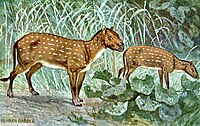User:Abyssal/Portal:Paleogene
IntroductionThe Paleogene Period (IPA: /ˈpeɪli.ədʒiːn, -li.oʊ-, ˈpæli-/ PAY-lee-ə-jeen, -lee-oh-, PAL-ee-; also spelled Palaeogene or Palæogene) is a geologic period and system that spans 43 million years from the end of the Cretaceous Period 66 Ma (million years ago) to the beginning of the Neogene Period 23.03 Ma. It is the first period of the Cenozoic Era and is divided into the Paleocene, Eocene, and Oligocene epochs. The earlier term Tertiary Period was used to define the time now covered by the Paleogene Period and subsequent Neogene Period; despite no longer being recognized as a formal stratigraphic term, "Tertiary" still sometimes remains in informal use. Paleogene is often abbreviated "Pg", although the United States Geological Survey uses the abbreviation "Pe" for the Paleogene on the Survey's geologic maps. During the Paleogene period, mammals continued to diversify from relatively small, simple forms into a large group of diverse animals in the wake of the Cretaceous–Paleogene extinction event that ended the preceding Cretaceous Period. (Full article...) Selected article on the Paleogene world and its legacies
Brachiopods are marine animals that have hard "valves" (shells) on the upper and lower surfaces, unlike the left and right arrangement in bivalvemolluscs. Brachiopod valves are hinged at the rear end, while the front can be opened for feeding or closed for protection. Two major groups are recognized, articulate and inarticulate. Articulate brachiopods have toothed hinges and simple opening and closing muscles, while inarticulate brachiopods have untoothed hinges and a more complex system of muscles used to keep the two halves aligned. In a typical brachiopod a stalk-like pedicle projects from an opening in one of the valves, known as the pedicle valve, attaching the animal to the seabed.
Lineages of brachiopods that have both fossil and extant taxa appeared in the early Cambrian, Ordovician, and Carboniferous periods, respectively. Other lineages have arisen and then become extinct, sometimes during severe mass extinctions. At their peak in the Paleozoic era, the brachiopods were among the most abundant filter-feeders and reef-builders, and occupied other ecological niches, including swimming in the jet-propulsion style of scallops. However, after the Permian–Triassic extinction event, brachiopods recovered only a third of their former diversity. It was often thought that brachiopods were in decline after the Permian–Triassic extinction, and were out-competed by bivalves. However, a study in 1980 found both brachiopod and bivalve species increased from the Paleozoic to modern times, but bivalves increased faster; after the Permian–Triassic extinction, brachiopods for the first time became less diverse than bivalves. (see more...) Did you know?
Need help?Do you have a question about Abyssal/Portal:Paleogene that you can't find the answer to? Consider asking it at the Wikipedia reference desk. Selected image
Selected article on the Paleogene in human science, culture and economicsThe Bone Wars is the name given to a period of intense fossil speculation and discovery during the Gilded Age of American history, marked by a heated rivalry between Edward Drinker Cope and Othniel Charles Marsh. The two paleontologists used underhanded methods to out-compete the other in the field, resorting to bribery, theft, and destruction of bones. The scientists also attacked each other in scientific publications, attempting to ruin the other's credibility and cut off his funding. Originally colleagues who were civil to each other, Cope and Marsh became bitter enemies after several personal slights between them. Their pursuit of bones led them west to rich bone beds in Colorado, Nebraska, and Wyoming. From 1877 to 1892, both paleontologists used their wealth and influence to finance their own expeditions and to procure services and fossils from dinosaur hunters. By the end of the Bone Wars, both men exhausted their funds in fueling their intense rivalry. Cope and Marsh were financially and socially ruined by their efforts to disgrace each other, but their contributions to science and the field of paleontology were massive; the scientists left behind tons of unopened boxes of fossils on their deaths. The feud between the two men led to over 142 new species of dinosaurs being discovered and described. Several historical books and fictional adaptations have also been published about this period of intense paleontological activity. (see more...) TopicsGeochronology - Paleogene (Paleocene - Eocene - Oligocene) Paleogene landmasses - Major Paleogene events - Paleogene biota appearances - Fossil sites - Stratigraphic units - History - History of paleontology - Timeline of paleontology Researchers - Culture - Treatise on Invertebrate Paleontology - Vertebrate Paleontology SubcategoriesQuality ContentThings you can doRelated contentAssociated WikimediaThe following Wikimedia Foundation sister projects provide more on this subject:
|





















